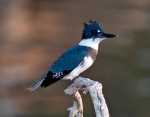I took the grandkids to Odell Lake/Lake Odell (I do get its name mixed up, but think it’s the former that is correct) for a quick exploration and to see what birds are around. The result? Not many. The Red-Winged Black Birds, Yellow-Headed Black Birds, and all the Swallows were gone. We saw some Mallards, American Coots, Canada Geese, a Turkey Vulture, and heard American Crows and a White-Breasted Nuthatch. However, the find of the day was a Belted Kingfisher.
The Belted Kingfisher seems to show up toward the end of summer, probably on its migration route, and we’ve seen it at the ponds of the Pinewood Country Club Golf Course during early fall. It is a fun bird to see and hear – definitely can be identified by its call, which has been described as a loud, penetrating rattle. It often calls when in flight.
Like the Steller’s Jay, the Belted Kingfisher has a bushy crest, and it is a similarly-sized bird with a big head but much larger beak. It is a blue-gray with a white breast that is accentuated with rust flanks and a belly band. Observing one up close or though a pair of binoculars gives you an opportunity to see what a striking bird it is.
The Belted Kingfished is found throughout the continental United States, so if you miss the one at Odell Lake, you might find it, like I do during the winter, at your Phoenix-area golf club or city park, assuming there is a pond or two. It consumes mainly fish and dives right into the water to capture an unsuspecting prey from a little below the surface. It also takes mollusks, small reptiles, young birds, small mammals, and even berries. Clear water is essential, and course it migrates south when ponds and lakes freeze over. It often is perched on a dead or tall branch of a tree as a good look-out spot, its flight is slow and direct, and sometimes it can be seen hovering over the water as it waits for that perfect moment to capture its next meal. Soon, however, it too will be headed further south in search of a more satisfactory food source.






